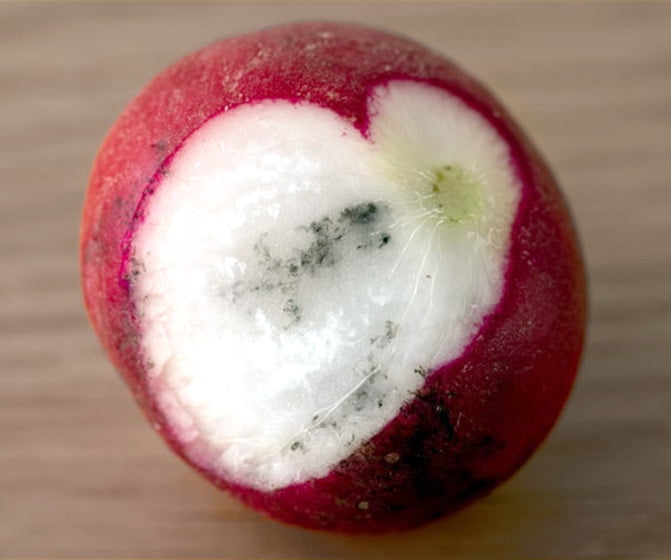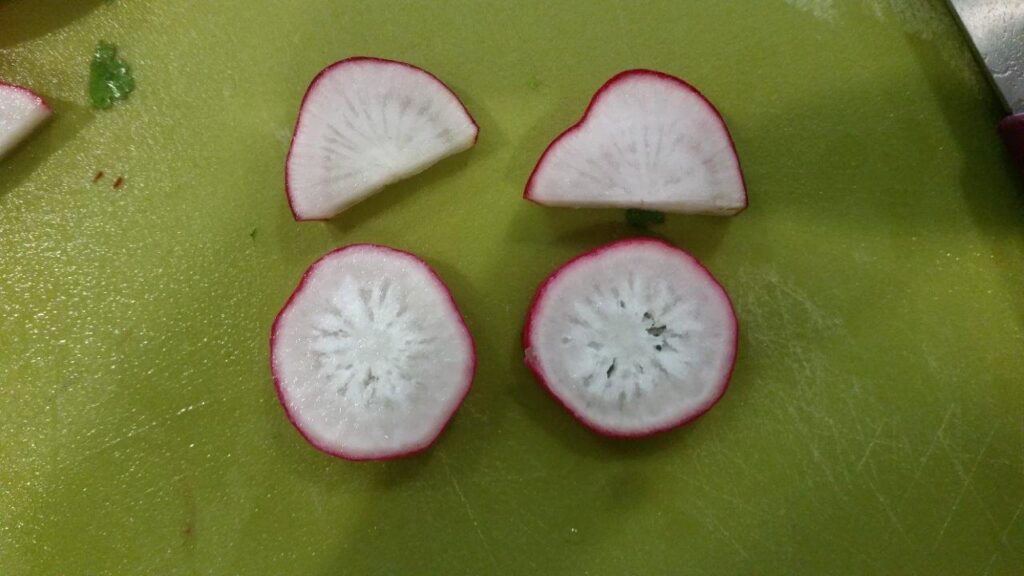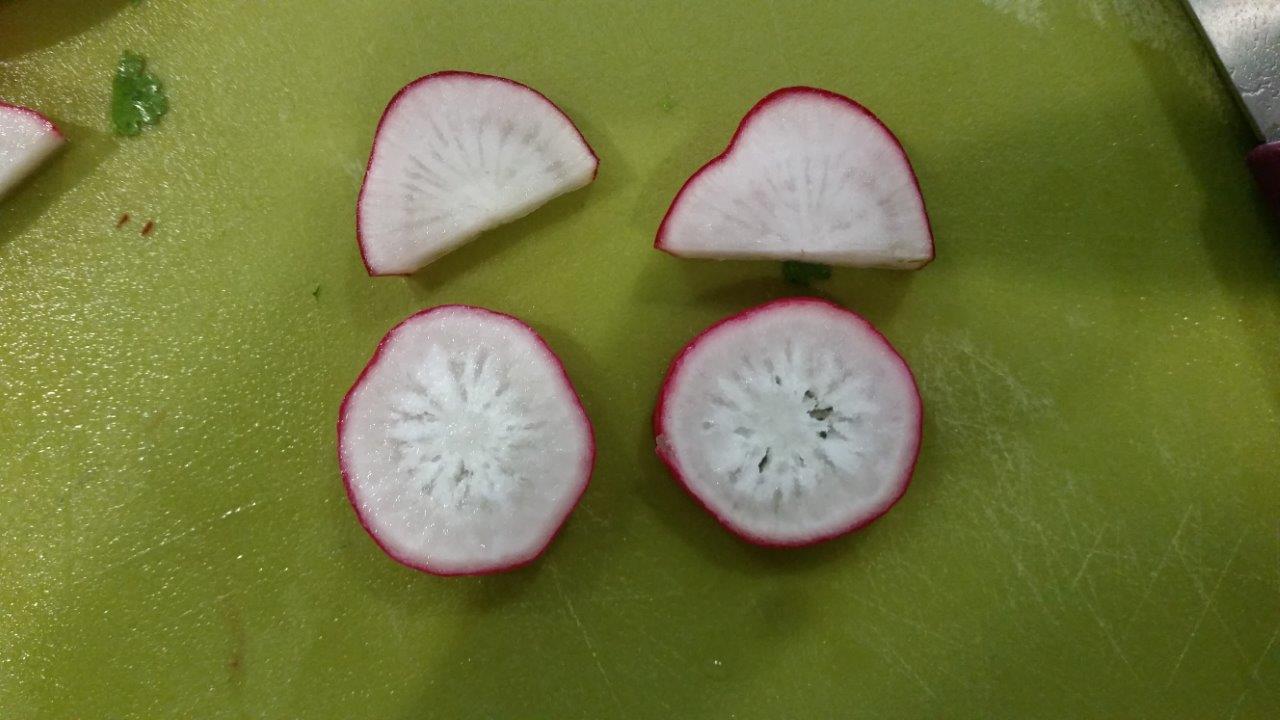So, you’ve recently bought a bunch of radishes and now you’re wondering how to tell if they have gone bad. Well, fret not! In this article, we’ll discuss some telltale signs that can help you determine when your radishes are no longer fresh and ready to be enjoyed. From changes in color and texture to the presence of mold, we’ll cover all the important indicators that will ensure you don’t end up with a disappointing radish experience. So, let’s dive right in and learn how to spot those signs that radishes have gone bad!

Physical Appearance
Wrinkled or Shrunk
When radishes have gone bad, one of the most noticeable signs is their wrinkled or shrunk appearance. Instead of a plump and firm texture, they will appear shriveled and may have a wilted look. This is because moisture loss occurs as the radishes age, causing them to lose their crispness and become less appealing.
Soft or Mushy
Another physical sign that radishes have gone bad is when they become soft or mushy to the touch. Normally, fresh radishes should be firm and slightly crunchy. However, as time goes on, the radishes break down and become softer. If they feel mushy or squishy, it’s a clear indication that they are past their prime and should be discarded.
Discoloration
Discoloration is another telltale sign that your radishes are no longer good to eat. Fresh radishes have a vibrant red or pink color, but when they start to spoil, their color may change. You may notice dark spots, brown patches, or even a grayish appearance. These discolorations are an indication of bacterial or fungal growth and suggest that the radishes should not be consumed.
Spoilage Spots
Spoilage spots are a common sign that radishes have gone bad. As radishes age, they are prone to developing soft, watery spots or patches on their skin. These spots may be discolored or have a slimy texture. These areas indicate that the radishes have started to decay and are no longer fresh.
Smell
Unpleasant Odor
The smell of radishes can be a good indicator of their freshness. Fresh radishes have a crisp and slightly peppery aroma. However, when they go bad, the smell changes significantly. If you detect a strong, pungent, or unpleasant odor coming from your radishes, it’s a sign that they have spoiled. This odor is usually a result of microbial growth and should be taken as a warning to avoid consuming the radishes.

Texture
Slimy
Radishes should never feel slimy to the touch. If you notice a slimy or slippery texture when handling your radishes, it’s a clear indication that they are no longer fresh. The sliminess is usually caused by bacteria or fungi that have started to grow on the surface of the radishes. In this state, the radishes can pose a risk to your health, and it’s best to throw them away.
Spongy
Fresh radishes should have a crisp and crunchy texture, but as they age, they may become spongy. When you bite into a radish and it feels soft or spongy rather than firm, it means that it has started to deteriorate. The spongy texture is a result of the breakdown of cell structure within the radish. Consuming spongy radishes is not recommended, as their taste and quality will have significantly diminished.
Dry
While it may seem contradictory, radishes can also go bad by becoming overly dry. As radishes lose moisture, they become dry and shriveled, which affects their taste and texture. Additionally, when the outer layer of the radish becomes dry, it can create a tough and fibrous texture that is not enjoyable to eat. When you notice excessive dryness in your radishes, it’s a sign that they are past their prime and should be discarded.
Taste
Bitter or Off-putting
When radishes go bad, their taste can become unpleasant or bitter. Normally, radishes have a tangy and slightly spicy flavor. However, as they deteriorate, they may develop a bitter taste or an off-putting flavor. This change in taste is a result of the breakdown of sugars in the radish and the accumulation of compounds that are typically associated with spoilage. If your radishes taste bitter or have an unpleasant flavor, it’s best to avoid consuming them.
Lack of Flavor
In contrast to the bitter or off-putting taste, radishes that have gone bad may also lack flavor altogether. Fresh, good-quality radishes have a distinct and vibrant flavor that adds a refreshing element to salads and other dishes. When radishes become old or spoil, their flavor diminishes significantly, and they may taste bland or even flavorless. If your radishes lack their characteristic flavor, it’s a strong indication that they are no longer fresh and should be discarded.

Storage Conditions
Improper Refrigeration
Proper refrigeration is essential for maintaining the freshness of radishes. If radishes are stored at room temperature or in a warm environment, they will deteriorate much faster. The ideal storage temperature for radishes is around 32-40°F (0-4°C). If they are exposed to higher temperatures, they will lose moisture rapidly, become wilted, and ultimately go bad sooner than expected.
Exposure to Moisture
While radishes require some moisture to stay fresh, excessive exposure to moisture can accelerate spoilage. Excess moisture can lead to the growth of bacteria and fungi, causing the radishes to become slimy, discolored, or develop spoilage spots. To prevent moisture-related issues, it is essential to store radishes in a breathable container or bag that allows for some airflow and to refrain from washing them until right before consumption.
Observing Mold
White and Fuzzy Growth
Mold growth is a clear sign that radishes are unfit for consumption. When radishes go bad and mold starts to develop, it often appears as a white and fuzzy growth on the surface of the radishes. This is usually caused by fungi colonizing the moist and decaying radishes. Eating moldy radishes can lead to health issues, especially for individuals with allergies or compromised immune systems, so it’s vital to discard them immediately.
Green or Black Spots
In addition to mold, green or black spots on radishes can indicate spoilage. These spots may appear as patches or as small dots scattered across the surface. Green spots are often a sign of chlorophyll breakdown, while black spots can result from fungal or bacterial growth. Regardless of the color, spotting on radishes indicates that they are no longer fresh and should not be consumed.

Long Duration
Expiration Date
Radishes, like most fresh produce, have a limited lifespan. Checking the expiration date on the radish packaging is a good starting point in determining their freshness. If the radishes have surpassed the indicated expiration date, it’s likely that they have already started to go bad and should be discarded. However, it’s important to note that the expiration date is just a guideline, and the actual freshness of the radishes can vary based on storage conditions and other factors.
Lengthy Storage
If radishes have been stored for an extended period, they are more likely to go bad. Even when stored properly, radishes have a relatively short shelf life, typically lasting around one to two weeks. As time goes on, the radishes will naturally deteriorate in quality, becoming wrinkled, soft, and potentially moldy. If you’ve had radishes sitting in your refrigerator for a month or more, it’s time to assess their condition carefully before considering their consumption.
Visible Signs of Decay
Slimy Leaves
When radishes start to go bad, the leaves attached to the radish can show signs of decay. The leaves may become slimy or develop a wet, sticky texture. These slimy leaves are an indication of moisture buildup, bacterial growth, or fungal activity. If the leaves are in poor condition or feel slimy, it’s likely that the radish itself has also deteriorated and should not be eaten.
Rotting Stems
In addition to slimy leaves, rotting stems are an obvious sign of radishes going bad. The stems of fresh radishes should be firm and green, providing support to the radish bulb. However, as radishes age or become spoiled, the stems may become soft, mushy, or even disintegrate. When the stems decay, it’s a clear indication that the radishes are no longer good to eat.
Disintegration
In the final stages of decay, radishes may start to disintegrate or break down completely. The outer layers may become mushy, and the radishes may lose their structural integrity. Disintegration can occur as a result of bacterial or fungal activity or due to moisture loss. Once radishes reach this point, they should be discarded immediately, as there is no salvageable portion left for consumption.

Insect Infestation
Presence of Bugs or Larvae
While not as common as some of the other signs, radishes can occasionally become infested with insects or larvae. If you notice small bugs or larvae crawling on or inside your radishes, it’s a clear indication of infestation. Insects and larvae can be harmful to consume and may indicate poor storage conditions or improper handling. If your radishes are infested, it’s best to dispose of them and thoroughly clean your storage area to prevent further infestations.
Unresponsive to Freshness Tests
Squeeze Test
When trying to determine radish freshness, the “squeeze test” is a commonly used method. Fresh radishes should feel firm and slightly springy when gently squeezed. However, if the radish feels mushy, squishy, or collapses under light pressure, it indicates that it has gone bad and should not be consumed.
Water Test
Another freshness test involves placing radishes in a bowl of water. If the radishes sink and stay submerged, it indicates that they are fresh. Conversely, if the radishes float on the surface or bob around, it suggests that they have deteriorated and are no longer at their best. While this test is not foolproof, it can provide some insight into the overall freshness of the radishes.
Snap Test
The snap test is often used to gauge the freshness of vegetables, including radishes. Grab a radish by its stem or top and try to break it. Fresh radishes will have a satisfying snap or crisp sound when they break. However, if the radish bends without breaking or feels soft and pliable, it means that it has lost its freshness and should be discarded.
By being aware of these various signs, you can easily identify when radishes have gone bad and avoid consuming potentially spoiled or unsafe produce. Remember to always prioritize safety and quality when it comes to your food, and when in doubt, it’s best to err on the side of caution and discard any radishes that display signs of spoilage.



